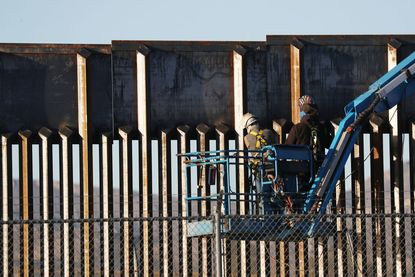Trump's border wall is slowly grinding into Texas private property. Very slowly.


U.S. Customs and Border Protection (CBP) leaders are still insisting President Trump will build 450 miles of new border wall before 2021, but few people in southern Texas think that's realistic. The obstacles to Trump's wall "include an investigation into construction contracts, funding delays, and a recent legal decision blocking emergency access to Defense Department funds to build it," The New York Times reports, but acquiring private lands "may be the tallest barrier standing between the president and his wall."
"Most of the borderlands in Texas are privately owned, unlike states to the west where a strip along the border is mostly federal property," NPR notes. In Texas' Rio Grande Valley, the Trump administration has acquired only 3 of the 110 miles of private borderland it wants for the wall. The government has sued 48 landowners for access to survey their property, the first step toward confiscation.
The government can probably seize most of the land, eventually, using eminent domain, and that inevitability has prompted some Texas landowners to reluctantly sell part of their property to the feds. "Adding to the heartache," the Times reports, in many cases "the construction is not on the border, which runs along the Rio Grande. It is well within the American side." Some landowners are fighting Trump in court.
Subscribe to The Week
Escape your echo chamber. Get the facts behind the news, plus analysis from multiple perspectives.

Sign up for The Week's Free Newsletters
From our morning news briefing to a weekly Good News Newsletter, get the best of The Week delivered directly to your inbox.
From our morning news briefing to a weekly Good News Newsletter, get the best of The Week delivered directly to your inbox.
"Construction has already fallen behind schedule because of how difficult it is to take private land," NPR reports. "Disorderly property records, complications with landowners, and a cumbersome condemnation process have slowed progress to a snail's pace. That's despite an army of federal land specialists trying to rush the process to please the president."
"Federal entities that acquire property have a process," Hyla Head, a former real estate specialist with the U.S. Army Corps of Engineers who spearheaded former President George W. Bush's push to seize borderlands in 2008, tells NPR. "You may not like it, but this is tried and true. We have laws to protect property owners." Of the more than 300 cases the Bush team brought against landowners, 46 are still open. Learn more in NPR's report below. Peter Weber
Create an account with the same email registered to your subscription to unlock access.
Sign up for Today's Best Articles in your inbox
A free daily email with the biggest news stories of the day – and the best features from TheWeek.com
Peter has worked as a news and culture writer and editor at The Week since the site's launch in 2008. He covers politics, world affairs, religion and cultural currents. His journalism career began as a copy editor at a financial newswire and has included editorial positions at The New York Times Magazine, Facts on File, and Oregon State University.
-
Why is Tesla stumbling?
In the Spotlight More competition, confusion about the future and a giant pay package for Elon Musk
By Joel Mathis, The Week US Published
-
 How Taylor Swift changed copyright negotiations in music
How Taylor Swift changed copyright negotiations in musicunder the radar The success of Taylor's Version rerecordings has put new pressure on record labels
By Theara Coleman, The Week US Published
-
 Job scams are increasingly common. Here's what to look out for.
Job scams are increasingly common. Here's what to look out for.The Explainer You should never pay for an application or give out your personal info before being hired
By Becca Stanek, The Week US Published
-
 OJ Simpson, star athlete tried for murder, dead at 76
OJ Simpson, star athlete tried for murder, dead at 76Speed Read The former football hero and murder suspect lost his battle with cancer
By Rafi Schwartz, The Week US Published
-
 Momofuku's 'Chili Crunch' trademark uproar
Momofuku's 'Chili Crunch' trademark uproarSpeed Read The company's attempt to own the sole rights has prompted backlash
By Rafi Schwartz, The Week US Published
-
 Kevin Hart awarded Mark Twain Prize
Kevin Hart awarded Mark Twain PrizeSpeed Read He is the 25th recipient of the prestigious comedy prize
By Peter Weber, The Week US Published
-
 Is Downton Abbey set to return for a final film?
Is Downton Abbey set to return for a final film?Speed Read Imelda Staunton reveals that a third movie may be in the pipeline
By Adrienne Wyper, The Week UK Published
-
 'Oppenheimer' sweeps Oscars with 7 wins
'Oppenheimer' sweeps Oscars with 7 winsspeed read The film won best picture, best director (Christopher Nolan) and best actor (Cillian Murphy)
By Peter Weber, The Week US Published
-
 'Rust' armorer convicted of manslaughter
'Rust' armorer convicted of manslaughterspeed read The film's cinematographer Halyna Hutchins was shot and killed by actor Alec Baldwin during rehearsal
By Peter Weber, The Week US Published
-
 The Beatles are getting 4 intersecting biopics
The Beatles are getting 4 intersecting biopicsSpeed Read Director Sam Mendes is making four separate movies, each told from the perspective of one band member
By Peter Weber, The Week US Published
-
 Taylor Swift to Miley Cyrus: female artists dominate 2024 Grammys
Taylor Swift to Miley Cyrus: female artists dominate 2024 GrammysSpeed Read SZA, Phoebe Bridgers and Lainey Wilson were also among the winners at LA gala
By Arion McNicoll, The Week UK Published